'A dogfight.' Waste disposal owner vows fight in Bourne bike path dispute
Aboard a burgundy, black and yellow freight engine manufactured in 1964, the omnipresent noise of clattering tracks and the staggered blows of the horn broke through the morning air on a recent Thursday in Buzzards Bay.
Slowly, at about 10 mph, the Massachusetts Coastal Railroad train No. 2009 passed over the Cape Cod Canal Railroad Bridge — hovering over the churning blue water, bound for a waste disposal site at the Upper Cape Regional Transfer Station within Joint Base Cape Cod.
Trainmaster Mike Valle, the conductor for the morning, and Assistant Trainmaster Kevin Owen, the engineer, have made the slow but steady trek down the Falmouth Secondary line to the transfer station many, many times.

“Myself and Kevin, we actually went to high school together,” Valle said as the train chugged south through Bourne, passing Monument Beach.
What is the Massachusetts Coastal Railroad?
Mass Coastal Railroad is a nearly 60-mile network of rail lines, stretching from Fall River to Hyannis.
The Falmouth Secondary line, or F2 line as it’s generally known, runs from the canal bridge, following the Buzzards Bay coastline south, to North Falmouth. The line then hooks east before reaching its terminus at the transfer station at the base.
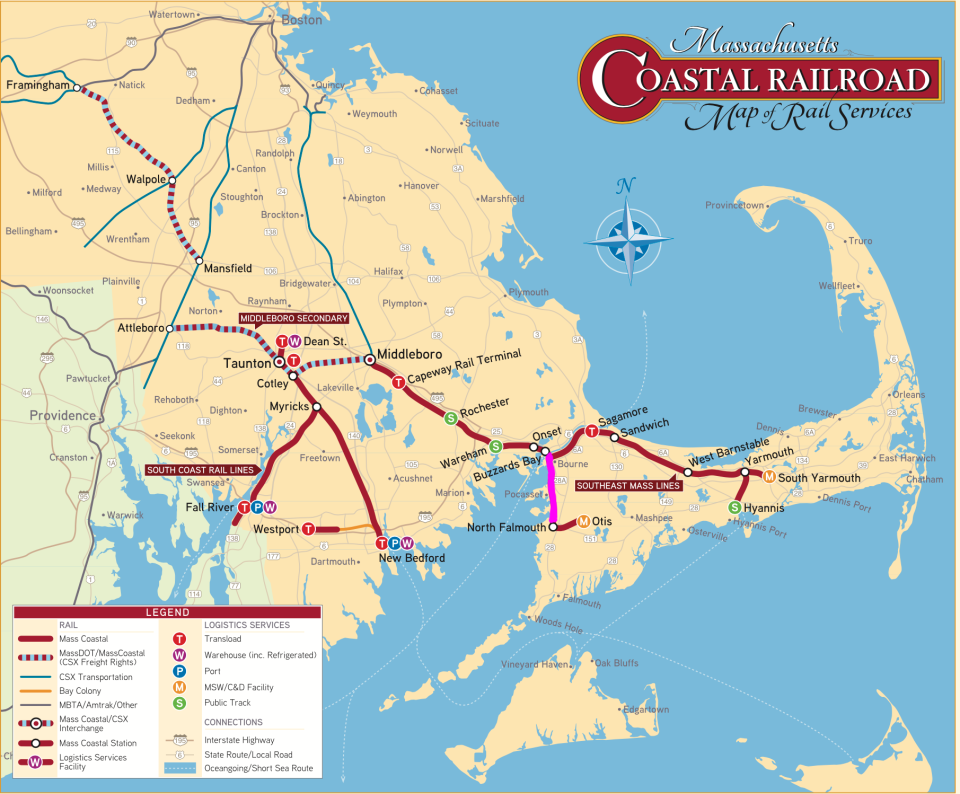
Valle and Owen were on their way to drop off eleven empty freight cars at the transfer station, operated by the private waste disposal company, Cavossa Disposal Corporation. Once there, they would then pick up eight cars they left there the previous week, now full of construction and demolition waste, or C&D.
The base has five military commands, and there are military uses of the F2 line as well, according to base spokesman Don Veitch.
Tear up the railroad tracks to put down a bike path
A community-driven effort to construct a 6 1/2-mile bike path, though, in place of the Falmouth Secondary line has put the train route at risk of disappearing. The so-called rail-to-trail plan — pulling up the tracks to create a bike path — has the backing of local officials in the town of Bourne, as well as state lawmakers.
The Bourne Rail Trail, as the bike plan is known, is part of a Cape Cod Commission project called Vision 88 — an initiative that aims to connect a network of 88 miles of multi-use paths and bike trails spanning the entire Cape, from Woods Hole to Provincetown. The Bourne Rail Trail, which currently has $20 million in federal funding available through the Cape Cod Regional Transit Authority, would be a vital link, according to proponents — connecting the existing bike path alongside the canal to the current Shining Sea Bikeway in Falmouth.
Thomas Cahir, administrator for the Cape Cod Regional Transit Authority, did not respond to several requests for comment.
A rail-with-trail alternative would build the bike path alongside the tracks.
“We don’t have any issues with that by any means,” Valle said of the alternative. “It’s just, why would you rip the rail up? This infrastructure has been here for over 100 years.”
Officials in favor of the plan of pulling up the tracks for a bike trail, though, said the alternative — keeping the railroad tracks with the bike path alongside — is nearly $70 million more expensive.
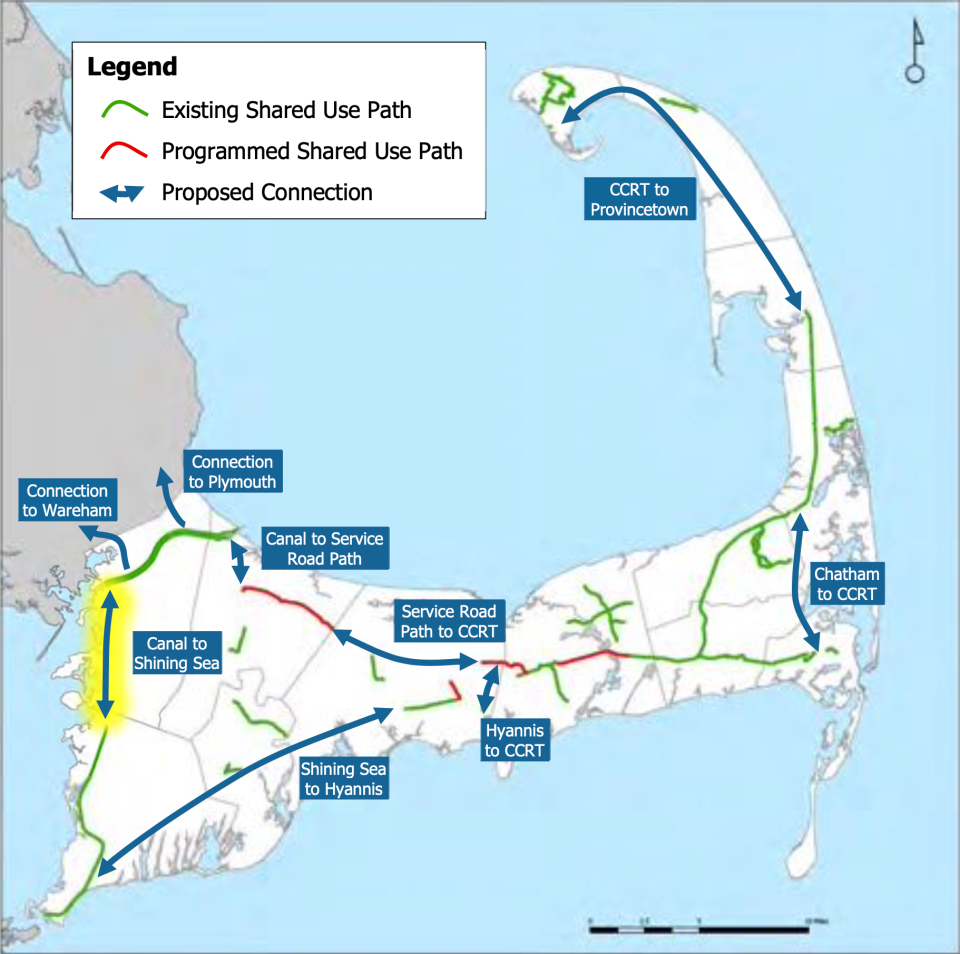
How is the Falmouth Secondary line used?
Joint Base Cape Cod uses the F2 line to haul trash and debris off the Cape, as well as for transportation for large-scale troop and equipment movement, Veitch wrote in an email to the Times. Removing the line would “deny the base vital capabilities for national defense,” Veitch wrote. He did not expand on what that entails, nor did Veitch expand on how often the military uses the line or if there were plans for expansion.
Veitch did not grant the Times an interview with Joint Base Cape Cod Executive Director Christopher Faux, providing the emailed comment instead.
Chris Podgurski, president and CEO of Mass Coastal Railroad, said the F2 line is used by the company for about three to four round trips a week, and is only used to transport construction and demolition waste. He said that he met with representatives from Joint Base Cape Cod to discuss expanding the use of the F2 line for additional military purposes.
The F2 line is also used by Cape Cod Central Railroad for day trips that include dining and sightseeing during the Cape's summer tourism season.
The F2 line — as well as the wider 58 1/2-mile network of southeastern Massachusetts rail lines — is owned by the state Department of Transportation, Podgurski said. The state agency purchased the network in the 1980s, and Podgurski said Mass Coastal operates these lines under a license and operating agreement that began in 2007.
“There's been a move nationally, as well as on the Cape and locally, to use abandoned right of ways, utility right of ways, railroad right of ways, for purposes of recreational trails, bike trails, and that kind of thing,” Podgurski said. “I think those are perfect uses for those corridors that are abandoned.”
He said the F2 line does not fall into that category. It's still serving the local and regional interests of waste disposal, he said.
“It's not what Mass Coastal has to lose, necessarily,” Podgurski said. “It's what the customers and the taxpayers of Cape Cod and the Islands have to lose, where they would lose a cost-competitive disposal facility.”
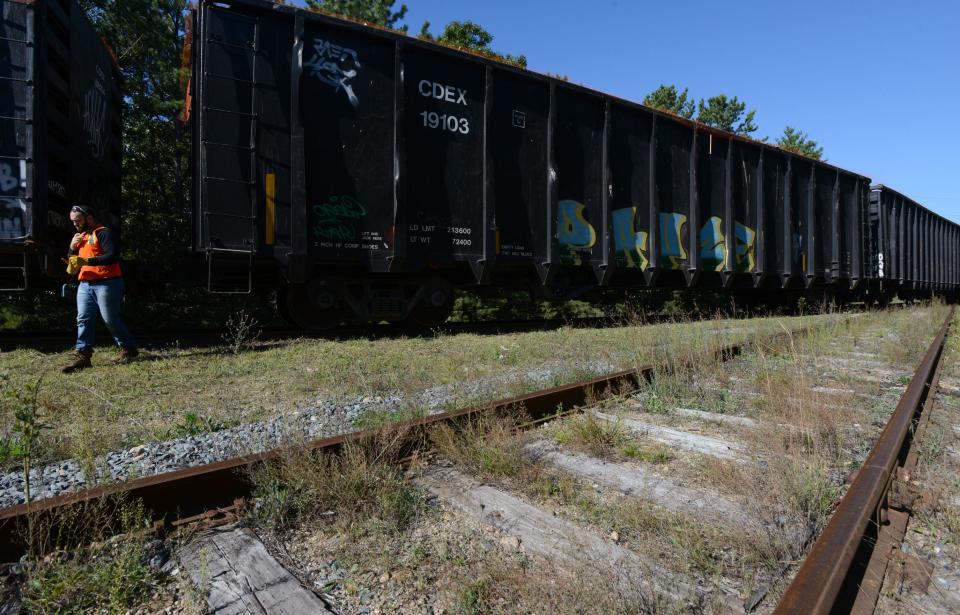
"We stop here"
The train makes a trip down the F2 line depending on the needs of Cavossa Disposal, the locally-owned business of Carl Cavossa. The trips are typically two to three times a week. On their trips, Valle said, they bring along eight to 12 empty freight cars, each able to carry around 85 to 100 tons of construction and demolition waste.
As the freight train neared the transfer station, dense woods hugged the track. Owen slowed the speed to brace for a stop.
“We stop here,” Owen said, pointing to a fork in the tracks that is used to guide the empty cars and full cars they would soon pick up from the Cavossa site. “It’s a puzzle, kind of.”
Once at the site, a crew of around five to eight men in hard hats and neon green construction shirts, some operating construction vehicles, work nonstop on a pile of construction and demolition waste to be loaded into the empty freight cars. Dump trucks from construction companies cycle in and out, offloading debris by the tons.
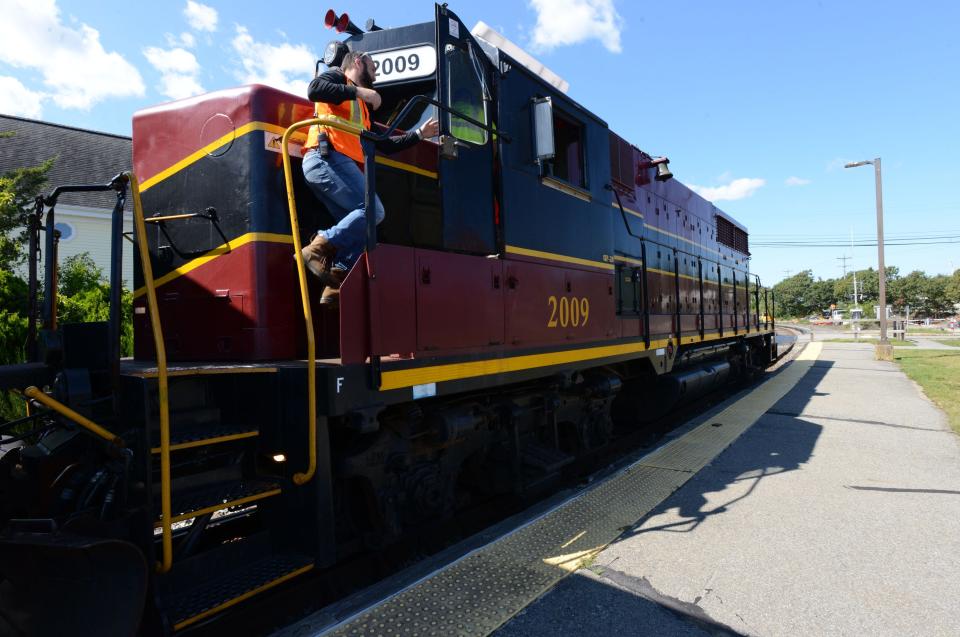
“We need the train,” said Cavossa site supervisor Charlie Gentry. “And I love coming here, you see all types of people that come here, truck drivers, carpenters, anyone that comes here, they’re all about us. And we’re all about the community.”
During the week, the Cavossa crew at the waste disposal site loads as many cars as they’re able. Much of what's originally brought to the waste disposal site is picked through and eventually taken to a recycling plant.
Trucks, alternatively, are able to carry around 28 tons of construction and demolition waste per truck, what is legally permitted under Massachusetts state law.
“I own land on the railroad, I’m working now and have been for two years on a permit on my own property to do business by rail,” Cavossa said. “The town of Bourne can’t stop me, they can’t take that away from me — they’re in for a dogfight.”
Cavossa, who served as the Falmouth Chamber of Commerce president in the mid-2000s, said the bike path would be great for tourism, and he is in favor of the rail-with-trail idea — a bike path alongside the railroad.
“I love the idea of rail-with-trail,” Cavossa said. But getting rid of the F2 line would “devastate my trash business for sure, it would obliterate my trash business,” he said.
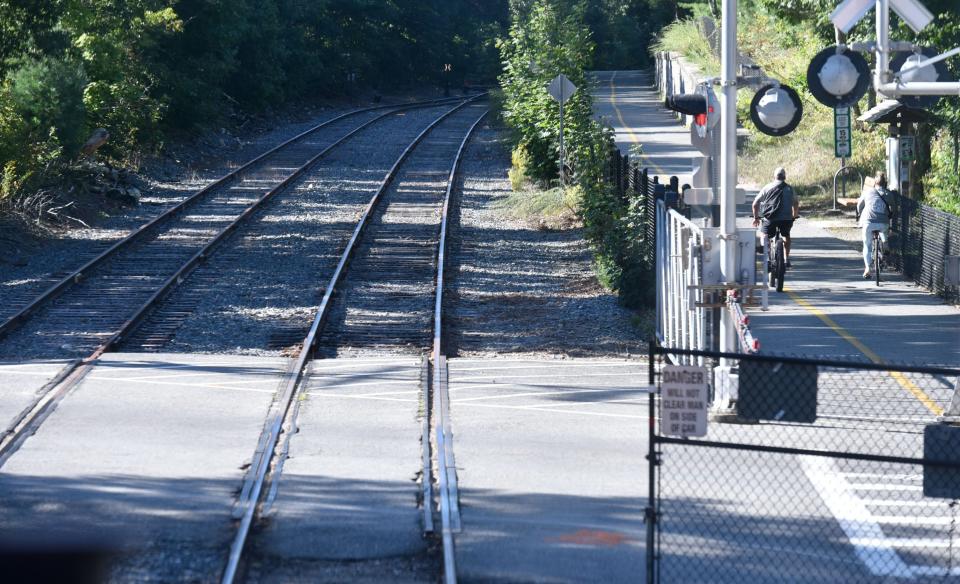
Moran: "The track right now is used very little"
State Sen. Susan Moran, D-Falmouth, is at the helm of the effort on the part of state lawmakers to see that the proposed rail-to-trail bike path gets finished. She said the project is about balancing the interests of the community with local economic incentives.
“The rail-to-trail trail just has proven itself, after years of review, to be the sensible path with the key element being that ,with the funding by the Cape Cod (Regional Transit Authority), it could happen immediately,” Moran said. “The track right now is used very little, and it's rated for about 10 mph.”
The rail-with-trail alternative would be more expensive because bridges would need to be expanded to include the bike path with the rail line, as well as a chain-link fence that would need to be built along the expanse of the track. The current estimated price for the rail-with-trail version is in the realm of $90 million, Moran said.
Mass Coastal: "Thousands of trucks off the road"
At the heart of Mass Coastal’s argument for keeping the F2 line in place is the number of trucks the rail line keeps off the road.
“We can take thousands of trucks off the road,” Valle said as the train chugged north, back through Bourne. “And the train is very fuel efficient. We use about 70 gallons of diesel fuel to make this run that would take about 120 trucks otherwise.”
According to Mass Coastal’s estimates, the rail line keeps 3,500 trucks off Cape roads each year.
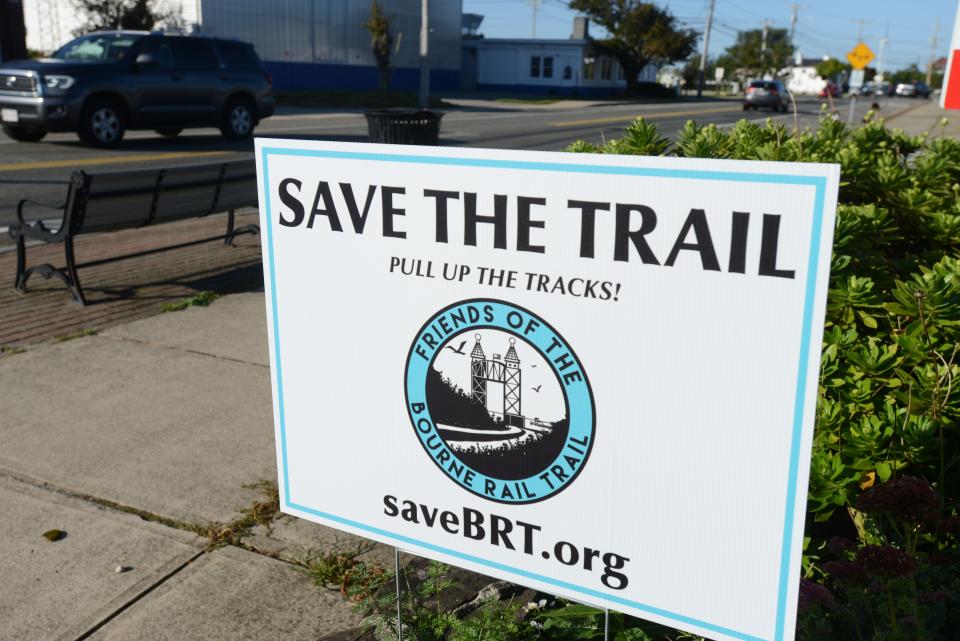
Ken Cheitlin, president of Friends of the Bourne Rail Trail, said their estimates are in the area of about six to seven trucks per hour, a figure he called “not a very significant load.” The motto for the group is "Save The Trail, Pull Up The Tracks!"
“With the new bridges coming on board, it's not a very significant additional load on the bridges either,” Cheitlin said. “While there is some increase, of course, in truck traffic, again, the public interest in having the trail greatly outweighs the rail.”
A "fantastic" extension to connect to the Cape Cod Canal bike trail
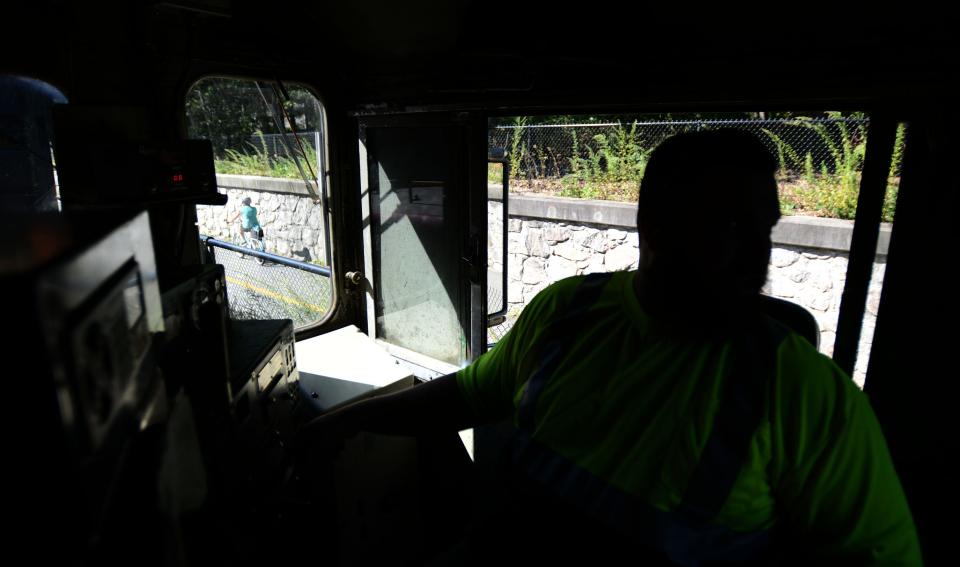
On that recent Thursday, in Falmouth, at the beginning of the Shining Sea Bike Path — and what would be the southern end of the proposed Bourne Rail Trail — Linda Howes, of New Hampshire, prepared for a long bike ride.
Howes, who rides several trails all over the Cape, said she is in favor of a rail-to-trail option because, she said, it would be quieter and safer for riders.
“The new proposal, for the extension to connect this to the Cape Cod Canal trail, that would just be fantastic,” Howes said. “It just really extends what you can do.”
Walker Armstrong reports on all things transportation and the Joint Base Cape Cod military base. Contact him at WArmstrong@gannett.com.
Thanks to our subscribers, who help make this coverage possible. If you are not a subscriber, please consider supporting quality local journalism with a Cape Cod Times subscription. Here are our subscription plans.
This article originally appeared on Cape Cod Times: Bourne bike path fans tout public interest; others cite truck traffic

